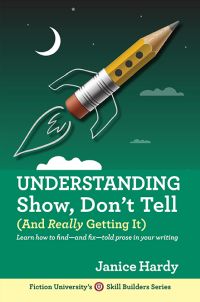Over the past few months, we’ve been enjoying tips on planning and revising in guest posts by the fantastic Janice Hardy. Her post on revising focused on backstory, an element our story needs but that also leads to readers skipping over our words if not written well.
Similarly, story description has a bad reputation for being skippable. Many readers will skim description, looking for the next exciting part with action or dialogue.
However, a story without description happens in a vacuum. At its worst, this issue is called the “floating head” problem, as characters’ disembodied heads “float” in a formless space, spouting dialogue into the void.
Janice is here this month to share advice and examples on how to make our descriptions less flat, less told, and therefore, less skippable. Please welcome Janice Hardy! *smile*
*****
Why Flat Description Falls Flat
Everything in a novel is the author describing the story to readers, but descriptions that do nothing more than explain what something looks like suck the life out of good text and can make it feel told, even when it’s not. It’s a statement of what the author knows is there, not how a character sees the world around her.
If the description is just what something looks like,
it’s a missed opportunity to evoke
emotion, characterize, or create a mood.
For example:
- The early summer sky was a ruddy brownish pink.
There’s nothing special about this line. It’s not bad, but it’s not a line that anyone is going to remember. But put it in the voice of a character, and show those same details through someone’s eyes, and it becomes memorable:
- The early summer sky was the color of cat vomit (Uglies, by Scott Westerfeld).
One line tells us what color the sky is; the other shows us how the character feels about looking at that color sky. And that shows readers a whole different sky. The point-of-view character and her worldview change how she sees the sky and how she chooses to describe it.
How a Character’s Voice and Emotions Affect Description
Let’s take a few random details in a scene and explore different ways to show the same scene:
- rain,
- a clock,
- a restaurant,
- a window,
- pancakes,
- and an envelope.
Flat Scene:
The rain poured down the window of the restaurant. Bob sat at the table, a stack of pancakes beside him. He stared at an envelope in his hands, while above him on the wall, a clocked ticked.
It’s not bad, but it has no life to it. The details do nothing to tell us more than what this scene looks like. Is Bob happy? Sad? Do you care what might be in that envelope? Probably not.
Now, let’s turn those same backdrop details into a living world by putting a person behind the description:
Navy SEAL:
The rain beat against the restaurant window like rounds from an Uzi. Bob sat at the table, back against the wall, a stack of uneaten pancakes beside him. He gripped the envelope tighter with every tick of the clock above him. New orders. Great.
Scared Girl:
Rain covered the window and blurred the outside world. Bobbi slouched at the table, her head barely higher than the stack of pancakes beside her. The envelope lay in her lap. She didn’t want to touch it, let alone open it. She glanced at the clock and sighed. Running out of time.
Same details, but notice how different these are from the original bland backdrop? In these examples, there’s a sense of who the point-of-view character is and what problem they might be facing.
4 Tips for Keeping a Description Strong
Some things to consider when writing descriptions:
- #1: Why is the Point-of-View Character Looking at Those Details?
Sometimes characters casually scan a room, sometimes they’re looking for something in particular, and sometimes they’re looking for a way to escape with their lives. The reasons for looking impact what they see and how they feel about it.
If your protagonist has no feelings at all about what’s around her, why are those details in the scene?
- #2: Which Details are Important to the Point-of-View Character?
People notice what’s important to them. A girl obsessed with fashion might notice what everyone is wearing, while a tired mom might not.
Spending time on details that mean nothing to your protagonist, or seem weird for your protagonist to care about, could make the prose feel told and knock readers out of the story.
- #3: Which Details Are Important to the Scene or Story?
Sometimes you need to put in a detail for plot reasons. Just tossing it in there might not be the best use of it, though. Too obvious a description or too much focus is like shining a light on it for readers. It practically screams, “Hey, pay attention here!” Maybe you want this, maybe you don’t, or maybe you want the clue to hide in plain sight for a surprise later.
If something needs to be seen, take a minute and think about how your point-of-view character might see it and how it can work with the scene, not just be in the scene.
- #4: What Tone, Theme, or Mood Do You Want to Achieve?
If you’re going for dark and creepy, describing bright and sunny could fight with your story, not help move it along. The right details give you opportunities for similes and metaphors that flow seamlessly and evoke feelings in your point-of-view character. They can help illustrate your theme in subtle ways. They can foreshadow and even raise the tension by suggesting something foreboding or mysterious.
Showing the right mood details adds to the emotion of a scene and provides opportunities for layering other elements.
Details mean different things to different people. How you show those details to readers helps them better understand not only what’s in the scene, but who’s in it as well. The right detail can instantly pique a reader’s interest and make them want to know more.
Don’t just create backdrops. Make your descriptions count.
*****
Win a 10-Page Critique From Janice Hardy
Three Books. Three Months. Three Chances to Win.
To celebrate the release of my newest writing books, I’m going on a three-month blog tour–and each month, one lucky winner will receive a 10-page critique from me.
It’s easy to enter. Simply visit leave a comment and enter the drawing via Rafflecopter. One entry per blog, but you can enter on every stop on the tour. At the end of each month, I’ll randomly choose a winner.
Check out my new book, Understanding Show, Don’t Tell (And Really Getting it), and learn what show, don’t tell means, how to spot told prose in your writing, and why common advice on how to fix it doesn’t always work.
Looking for tips on revising your novel? Check out Revising Your Novel: First Draft to Finished Draft, a series of self-guided workshops that help you revise your manuscript into a finished novel.
Still working on your idea? Then try Planning Your Novel: Ideas and Structure and Planning Your Novel Workbook.
*****
 Janice Hardy is the award-winning author of The Healing Wars trilogy and the Foundations of Fiction series, including Planning Your Novel: Ideas and Structure, a self-guided workshop for planning or revising a novel, the companion Planning Your Novel Workbook, Revising Your Novel: First Draft to Finished Draft, and the first book in her Skill Builders Series, Understanding Show, Don’t Tell (And Really Getting It).
Janice Hardy is the award-winning author of The Healing Wars trilogy and the Foundations of Fiction series, including Planning Your Novel: Ideas and Structure, a self-guided workshop for planning or revising a novel, the companion Planning Your Novel Workbook, Revising Your Novel: First Draft to Finished Draft, and the first book in her Skill Builders Series, Understanding Show, Don’t Tell (And Really Getting It).
She’s also the founder of the writing site, Fiction University. For more advice and helpful writing tips, visit her at www.fiction-university.com or @Janice_Hardy.
Website | Facebook | Twitter | Goodreads
Amazon | Barnes & Noble | iTunes | Indie Bound
*****
Thank you for sharing this excerpt from your new book, Janice! Flat descriptions were one of the first mistakes I was able to find in my writing (as my pages of description in my currently-under-the-metaphorical-bed story made it obvious that I was doing something wrong! *grin*), so I always love seeing new ways of explaining how to attack this common problem.
We can hear advice from many sources about how we need to put descriptions in a character’s point-of-view, but sometimes we don’t really get it until we see examples of the technique. Hopefully these examples will help the concept “click” for others.
I also love the four questions we can use to figure out what to focus on in our descriptions. I especially appreciated the advice for how to include description that might not “fit” the character’s thoughts but that we need to include anyway. Adding that detail in an active way—giving our characters something to do with the description detail—helps ensure it’s on the page for a reason. Having a description detail active in a scene establishes characters (and our readers) more firmly within the story.
The more we can show our story, the more easily readers become immersed in our words. Especially when it comes to descriptions—an element notorious for making readers skim—if we can show a setting through our character’s point of view, our readers will have one less escape from our story. *smile*
Do you struggle with descriptions? Do you tell your readers what’s in a scene, or do you show them? If you’ve fixed this problem in your writing, what advice helped you the most? Which of those four tips is most helpful or insightful to you? Do you have any questions for Janice?


